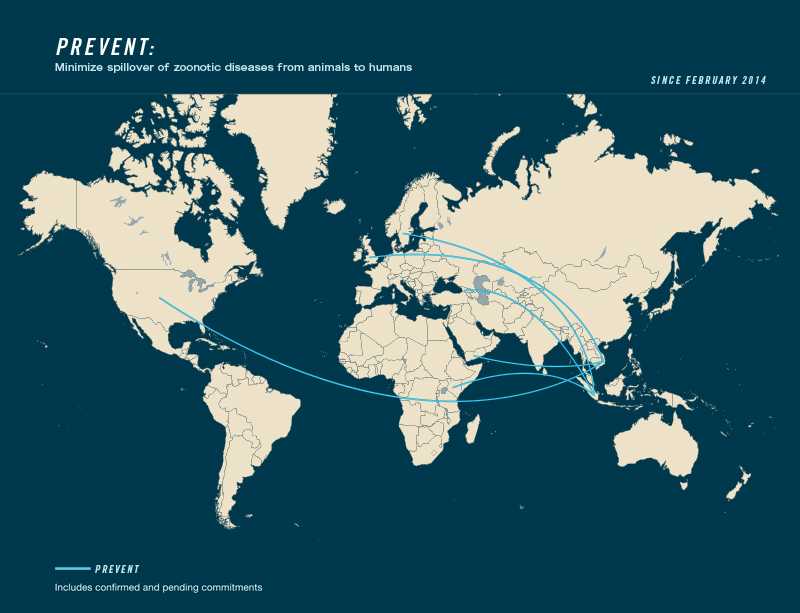Global Health Security Agenda: GHSA Zoonotic Disease Action Package (GHSA Action Package Prevent-2)
 Five-Year Target: Adopted measured behaviors, policies and/or practices that minimize the spillover of zoonotic diseases from lower animals into human populations.
Five-Year Target: Adopted measured behaviors, policies and/or practices that minimize the spillover of zoonotic diseases from lower animals into human populations.
As Measured by: Identify the five zoonotic diseases/pathogens of greatest public health concern and strengthen existing surveillance systems for prioritized zoonoses.
Desired National Impact: Implementation of guidance and models on behaviors, policies and practices to minimize the spillover, spread, and full emergence of zoonotic disease into or out of human populations prior to the development of efficient human-to-human transmission. Nations will develop and implement operational frameworks—based on international standards, guidelines, and successful existing models—that specify the actions necessary to promote One Health approaches to policies, practices and behaviors that could minimize the risk of zoonotic disease emergence and spread.
Country Commitments to Action Package:- Leading countries: Indonesia, Vietnam
- Contributing countries: Georgia, Kenya, Sweden, United Kingdom, United States, Yemen
- Contributing international organizations: FAO, OIE, WHO
Five-Year Action Items:
Actions shall be coordinated with FAO, OIE and WHO as relevant international organizations.
- Emphasize One Health approaches across all relevant sectors of government with the goal of detecting and controlling zoonotic threats while they are still in animal populations. This approach should enhance national ability to meet international standards and improve the quality of human and animal health systems via the WHO IHR Monitoring Framework and the OIE PVS Pathway.
- Implement joint IHR and PVS training programs for human and animal health services.
- Increase the compatibility of existing animal and human diagnostics and surveillance data fields, avoiding the creation of new data systems wherever possible.
- Introduce and advice national multi-sectoral policies and regulatory guidelines promoting poultry and livestock production and marketing practices that minimize the risk of zoonotic disease emergence, including food safety policies and guidelines as well as legislation reinforcing veterinary supervision of the use of antibiotics in animals.
- Support the implementation of national architecture for real-time bio-surveillance, spanning animal and human populations to support disease monitoring, reporting and analysis via bio-surveillance of high-risk wildlife groups (i.e., birds, bats, etc.)
- Actively address the proposal of core competencies and systems requirements (e.g., laboratory methods, surveillance data fields) for implementation of the surveillance system.
- Enhance, link, and increase analytic capability within disease reporting systems (WHO, WAHIS), to ensure that WHO, FAO, and OIE receive pertinent information.
- Introduce an operational framework that supports multi-sectoral notification for outbreaks of suspected zoonotic origin in the early stage of emergence (prior to efficient human-to-human transmission). The framework should address outbreaks that occur in both animals and humans at a similar time and/or place.
- Introduce systems that promote complementary research, for public health purposes, and analysis within and across countries for enhanced prevention, detection and response activities for emerging zoonotic diseases.
Baseline Assessment and Planning Activities
- Use WHO’s IHR Monitoring Framework and OIE’s PVS Pathways as instruments to identify countries’ priorities for strengthening core competencies.
- Identify core competencies and systems requirements (e.g., laboratory methods, surveillance data fields) necessary for implementation of an operational framework, policies, guidelines and method of surveillance.)
- Determine where it will be possible to enhance surveillance and laboratory diagnostics for selected priority zoonotic diseases to aid in early detection. Such an approach would be preferable to the establishment of new electronic disease surveillance systems.
Monitoring and Evaluation Activities
- Monitoring activities through Implementation of WHO’s IHR Monitoring Framework and the OIE’s PVS Pathway.
- Evaluate the implementation of appropriate One Health policies in national operational frameworks to minimize the risk of zoonotic disease emergence and spread.
- Page last reviewed: December 23, 2014
- Page last updated: December 23, 2014
- Content source:
Global Health
Notice: Linking to a non-federal site does not constitute an endorsement by HHS, CDC or any of its employees of the sponsors or the information and products presented on the site.


 ShareCompartir
ShareCompartir